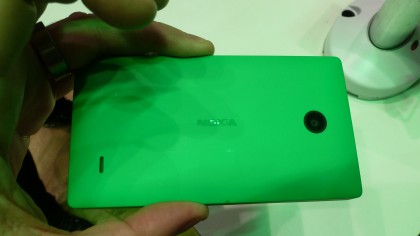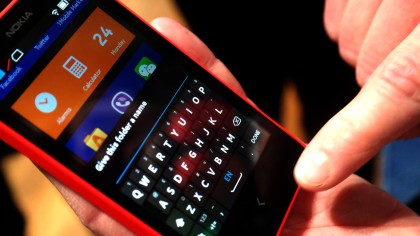Why the Nokia X is the best phone you'll never buy
Robot love
What we inevitably come back to is what we started with - the fact that the Nokia X runs Android. Even over here where we're drowning in Android phones that's an intriguing notion, as the much loved Finnish firm has long been in bed with Microsoft, so an Android handset has been nothing more than a fantasy until now.
But Android is far and away the most popular smartphone OS on Earth with a 78.6% global smartphone market share in 2013 according to IDC, so for a popular smartphone maker to get on board with such a popular operating system was bound to lead to sales.
Yet with all that Android competition there could have been a risk of the Nokia X getting lost in a sea of similarly specced handsets. But that was avoided too because the Android you get on the Nokia X is not Android as you know it.
It's more akin to Amazon's take on the open source OS, in that it's taken Android as its basis but stripped out all of Google's services (including access to Google Play) and put Nokia and Microsoft services in their place.
The absence of Google Play sounds like a big deal, but in some places it might not be such a factor. Passos explained that "there are many countries, such as China, where Google Play is not available. In others, it's not the primary choice" and users still have access to third party app stores.
The Nokia X and its siblings have also been heavily skinned to include a tile based interface that looks more than a little like Windows Phone.
So it stands out from the Android crowd and buyers of the handset can fall safely into the arms of Android while experiencing many aspects of Windows Phone, potentially pushing them to switch to a true Windows Phone handset when they upgrade. More specifically a Lumia handset, since this is a Nokia phone we're talking about and it's even decked out like a Lumia.
Sign up for breaking news, reviews, opinion, top tech deals, and more.
Indeed that's clearly part of the strategy, as Passos explained that "Lumia remains our primary smartphone strategy, while the Nokia X family, which includes the X, X+ and XL, serves as an introductory system to Lumia. The Nokia X user interface ties directly into our strategy of providing an 'on ramp' for Lumia."

Of course even users that stick with the Nokia X will find themselves in Microsoft's fold, as the handset uses Bing, One Drive and other Microsoft and Nokia services in place of their Google counterparts.
Passos agreed, saying that "one of the great benefits of the Nokia X family is that it will help to introduce millions more people to popular Microsoft services that work across Nokia X and Lumia. Those services will become central to the online lives of the next billion and they will be able to access them using either Android or Windows phones."
And the key point is that this is a strategy that is getting users over to Microsoft's side rather than Google's. It's using Android to keep users away from, well, Android.
That's something that wouldn't be as easy with Windows Phone, as it's a relatively unpopular operating system, with a global smartphone market share of just 3.3% in 2013 according to IDC, but with the heavy skinning of the Nokia X the awareness of the Windows Phone experience will grow, even while people aren't actually using Windows Phone itself.
And by offering three different handsets in the 'X' range Microsoft arguably has the low end of the market sewn up, with the Nokia X being aimed at the very entry level, the Nokia X+ aimed at those who want slightly better specs and the XL at users who want something with a larger screen.
Looking forward
Passos wouldn't be drawn on what the future of the Nokia X brand will be, but it's seemingly been a hit so far and the Nokia X2 is now launching in various countries around the world, just half a year after the initial model was announced.
So it seems that Microsoft is committed to the brand for now at least and while it's too early to get sales figures for the X2 we'd expect that it will do well.
That said, the X2 is almost as low-end as its predecessors so it seems more aimed as a replacement for the Nokia X than a higher end option. By sticking to low-end devices Microsoft and Nokia are presenting anyone who wants to upgrade with a tough choice: either ditch Microsoft's services and move to a standard Android handset or ditch Android and move to Windows Phone.
Presumably Microsoft is banking on the latter happening, but Hassan is sceptical, saying that "I think most people will buy an Android device (for their next phone). The idea of migrating to a less-mature OS with lesser apps seems unlikely. It's highly probable that the phone will be higher end and Nokia doesn't make a higher-end Android phone right now.
"Yes, Nokia has worked hard to transmute the OS into Windows Phone but I don't think most people can be lured."

Passos meanwhile is optimistic about the Nokia X range, saying that "one billion more people will be connected to the internet in the next few years. We know that they live mainly in high growth markets, they are mostly young people and their first experience of the Internet will be on a mobile device.
"We see this as a huge opportunity to place mobile phone innovation and Microsoft services into their hands, to enable their first experiences of the internet, apps and the cloud."
In other words Microsoft wants to be at the forefront of bringing in the next billion smartphone users and with the Nokia X and Nokia X2 it just might manage it, but whether those users will stick around when they need a new phone is another matter entirely.
- The Nokia X isn't the only cheap smartphone around.
- 1
- 2
Current page: Page two - The Nokia X: what's its secret?
Prev Page Page one - The Nokia X: what's its secret?James is a freelance phones, tablets and wearables writer and sub-editor at TechRadar. He has a love for everything ‘smart’, from watches to lights, and can often be found arguing with AI assistants or drowning in the latest apps. James also contributes to 3G.co.uk, 4G.co.uk and 5G.co.uk and has written for T3, Digital Camera World, Clarity Media and others, with work on the web, in print and on TV.